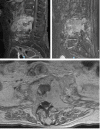Uncorrect diagnosis of tubercolar spondylodiscitis in aggressive and bone destructive metastasis of melanoma: A case report and literature review
- PMID: 32913605
- PMCID: PMC7459377
- DOI: 10.4081/or.2020.8674
Uncorrect diagnosis of tubercolar spondylodiscitis in aggressive and bone destructive metastasis of melanoma: A case report and literature review
Abstract
Differential diagnosis of destructive osteolytic spinal lesions can be a diagnostic challenge. In this study, we described a rare case of spinal metastases from primary desmoplastic melanoma which had incorrectly been diagnosed and treated as tuberculous spondylodiscitis. An 82-year-old male patient with ongoing low back pain and a history of lumbar localized Pott's performed a lumbar spine MRI that showed osteolytic lesion with first hypothesis of spondylodiscitis L2-L3. The patient was hospitalized and cause of worsening of the lumbar pain underwent a following series of non-diagnostic CT-guided and open lumbar biopsy at L2-L3 with unsuccessful antibiotic-antitubercular therapy. A new MRI revealed a worsening of previous lesions, extension of the osteolytic lesion at the level of L1-L2 and L3-L4 with neurological impairment. The diagnosis of metastatic melanoma was obtained with surgical decompression and open posterior biopsy procedure. The case described is pathognomonic of the difficulty in detecting the correct diagnosis in front of similar clinical and radiological manifestations. The presence of a previous Pott's disease in the same involved vertebral site was of crucial importance in deflecting the correct diagnostic classification of the pathology, which was possible to ascertain only following an extensive biopsy sampling in the last surgery performed.
Keywords: Malignant Melanoma; Osteolytic spinal lesion; Spinal metastases; Tubercolar spondylodiscitis.
©Copyright: the Author(s).
Conflict of interest statement
Conflict of interest: the authors declare no potential conflict of interest.
Figures



Similar articles
-
Pott's paraplegia and role of neuroimaging in resource limited setting: A case report and brief review of the literatures.J Clin Tuberc Other Mycobact Dis. 2021 Oct 19;25:100283. doi: 10.1016/j.jctube.2021.100283. eCollection 2021 Dec. J Clin Tuberc Other Mycobact Dis. 2021. PMID: 34729422 Free PMC article.
-
Fracture of the Lumbar Spine Associated with Ureteral Injury Mimicking Spondylodiscitis Followed by Cervical Spine Fracture in Patient with Ankylosing Hyperostosis.J Clin Med. 2023 Nov 5;12(21):6937. doi: 10.3390/jcm12216937. J Clin Med. 2023. PMID: 37959402 Free PMC article.
-
A rare case of tertiary syphilis spondylodiscitis of the upper cervical spine: Diagnostic and therapeutic complexity, review of literature.Orthop Rev (Pavia). 2020 Jun 25;12(Suppl 1):8675. doi: 10.4081/or.2020.8675. eCollection 2020 Jun 29. Orthop Rev (Pavia). 2020. PMID: 32913606 Free PMC article.
-
Lumbar Spondylodiscitis Mimicking Cholecystitis: A Case Report and Review of Literature.J Neurol Surg A Cent Eur Neurosurg. 2023 Jan;84(1):95-102. doi: 10.1055/a-1811-7393. Epub 2022 Mar 30. J Neurol Surg A Cent Eur Neurosurg. 2023. PMID: 35354214
-
Management of lumbar spondylodiscitis developing after laparoscopic sacrohysteropexy with a mesh: A case report and review of the literature.Medicine (Baltimore). 2019 Dec;98(49):e18252. doi: 10.1097/MD.0000000000018252. Medicine (Baltimore). 2019. PMID: 31804356 Free PMC article. Review.
Cited by
-
A Detailed Analysis of Clinical Features and Outcomes of Patients with Pyogenic Spondylodiscitis Presenting without Axial Back Pain.Trop Med Infect Dis. 2021 Apr 20;6(2):54. doi: 10.3390/tropicalmed6020054. Trop Med Infect Dis. 2021. PMID: 33923885 Free PMC article.
References
-
- Harrington KD. Orthopedic surgical management of skeletal complications. Cancer 1997;80:1614-27. - PubMed
-
- Sundaresan N, Digiacinto GV, Hughes JE, et al. Treatment of neoplastic spinal cord compression: results of a prospective. Neurosurgery, 1991. pp. 29:645-650. - PubMed
-
- Barzilai O, Laufer L, Yamada Y. Integrating Evidence-Based Medicine for Treatment of Spinal Metastases Into a Decision Framework: Neurologic, Oncologic, Mechanicals Stability, and Systemic Disease. J Clin Oncol 2017; 35:2419-27. - PubMed
-
- Witham TF, Khavkin YA, Gallia GL. Surgery insight: current management of epidural spinal cord compression from metastatic spine disease. Nat Clin Pract Neurol 2006:87-94. - PubMed
-
- Perrin RG, Laxton AW. Metastatic spine disease: epidemiology, pathophysiology, and evaluation of patients. Neurosurg Clin N Am 2004;15:365-73. - PubMed
LinkOut - more resources
Full Text Sources

